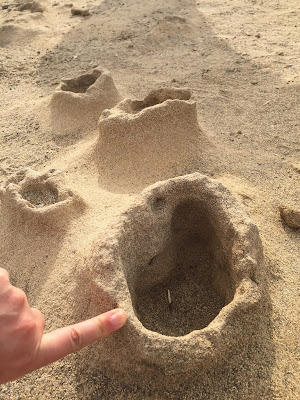Well hello everyone!
I am writing to you from La Isla Bonita, the beautiful
volcanic island of La Palma in the Canaries.
And why am I here you all ask?
I was offered an "I'd be mad to turn it down"
opportunity. An internship through GeoTenerife working alongside teams from
Instituto Tecnológico y de Energias Renovables and El Centro Nacional de Volcanologica
o Instituto Volcanológico de Canarias. The purpose? Well every summer when the
weather is much better (less wind) teams spend several months on many of the
Canary islands collecting soil gas samples that aid in the monitoring of the
volcanoes that form these beautiful oceanic islands. Though mother nature in
her infinite wisdom is incredibly difficult to predict, Methods used can help
detect patterns and spikes that may indicate the start some kind of unrest and the authorities can act accordingly.
For those who remember Mount St. Helen's, even in 1980, the
scientists predicted something big was going to happen, but mother nature
changed her mind until the very last few days, by which time it was too late.
Lessons, however, were learnt. And although a volcanic eruption is almost
impossible to predict (eg. Calbuco in Chile and Shindake in Japan have erupted
in the last few months without warning) constant monitoring can at least aid in
the development of evacuation procedures, develop models for the future
and raise awareness. And in the meantime locals
and tourists alike can visit the volcanoes in the knowledge that people are
watching, monitoring, ensuring their safety as best as they possibly can.
Many of the methods used to sample for gases when involved
in volcanic hazard monitoring can also be applied in the research of geothermal
fields where the need to identify active fracture networks is paramount in the success of a geothermal field.
So here I am, learning. Learning never really ends! It doesn't matter if you are just starting out in your chosen scientific career, or have been at it for years, there is always something new and interesting (and often vital) to learn about.
There are four interns during June, myself, Hannah a
geography undergraduate at Bristol, Ariane an MSci student at UCL and Trevor an
undergraduate in Earth Sciences from Wooster College in Ohio, USA.
The four of us with our trusty guide Ignasio at Las Canadas Caldera, Mount Teide in the bcackground.
I left Glasgow on an early morning (Thursday 4th June) flight to
Tenerife and met with Trevor and our guide Ignasio. We made our way to our
accommodation in El Medano, home for a few days as myself and Hannah are to
work on La Palma while Ariane and Trevor will remain on Tenerife. On the Friday
Ariane and Hannah were set to arrive mid-late evening, so myself and Trevor
went for a little exploration along the coast, almost straight away coming
across several generations of welded tuff, flip-flop for scale.
Welded tuff, flip-flop for scale!
On walking along the coast towards the small volcanic centre
Montańe Roja we discover area littered with fossil steam vents.
Fossil steam vents
There was a fossil dune system with cross beds that were
not always easy to spot just a short distance away.
It wasn't a long walk, spending just a few hours exploring,
but it was enough to justify a lunch time beer, feet up watching the kite
surfing. Apparently the International Kite Surfing Champs are held right here
on this beach.
Buenas noches de La Palma!




No comments:
Post a Comment